coolant INFINITI QX50 2021 Owner's Manual
[x] Cancel search | Manufacturer: INFINITI, Model Year: 2021, Model line: QX50, Model: INFINITI QX50 2021Pages: 542, PDF Size: 3.51 MB
Page 3 of 542
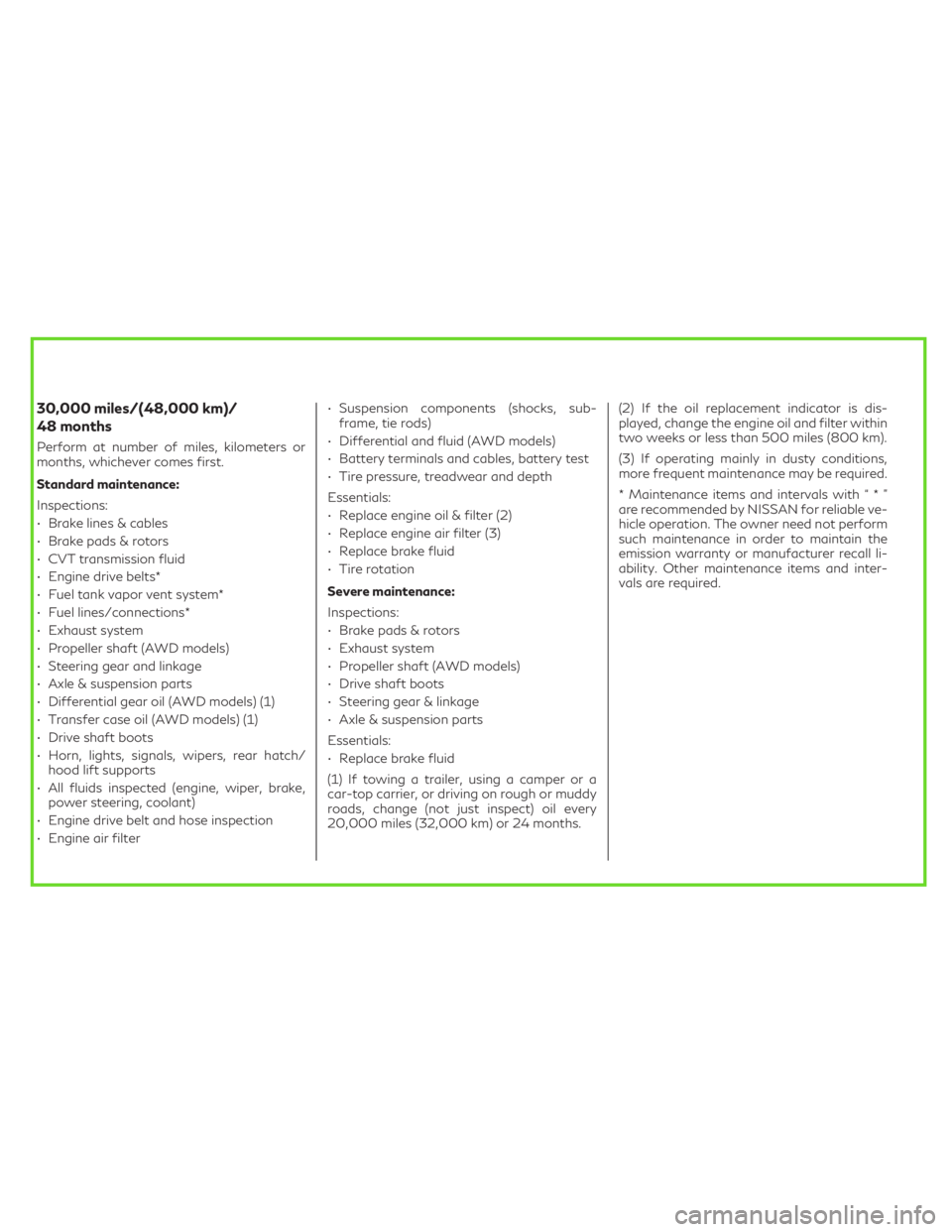
30,000 miles/(48,000 km)/
48 months
Perform at number of miles, kilometers or
months, whichever comes first.
Standard maintenance:
Inspections:
• Brake lines & cables
• Brake pads & rotors
• CVT transmission fluid
• Engine drive belts*
• Fuel tank vapor vent system*
• Fuel lines/connections*
• Exhaust system
• Propeller shaft (AWD models)
• Steering gear and linkage
• Axle & suspension parts
• Differential gear oil (AWD models) (1)
• Transfer case oil (AWD models) (1)
• Drive shaft boots
• Horn, lights, signals, wipers, rear hatch/
hood lift supports
• All fluids inspected (engine, wiper, brake,
power steering, coolant)
• Engine drive belt and hose inspection
• Engine air filter• Suspension components (shocks, sub-
frame, tie rods)
• Differential and fluid (AWD models)
• Battery terminals and cables, battery test
• Tire pressure, treadwear and depth
Essentials:
• Replace engine oil & filter (2)
• Replace engine air filter (3)
• Replace brake fluid
• Tire rotation
Severe maintenance:
Inspections:
• Brake pads & rotors
• Exhaust system
• Propeller shaft (AWD models)
• Drive shaft boots
• Steering gear & linkage
• Axle & suspension parts
Essentials:
• Replace brake fluid
(1) If towing a trailer, using a camper or a
car-top carrier, or driving on rough or muddy
roads, change (not just inspect) oil every
20,000 miles (32,000 km) or 24 months.(2) If the oil replacement indicator is dis-
played, change the engine oil and filter within
two weeks or less than 500 miles (800 km).
(3) If operating mainly in dusty conditions,
more frequent maintenance may be required.
* Maintenance items and intervals with“*”
are recommended by NISSAN for reliable ve-
hicle operation. The owner need not perform
such maintenance in order to maintain the
emission warranty or manufacturer recall li-
ability. Other maintenance items and inter-
vals are required.
Page 18 of 542
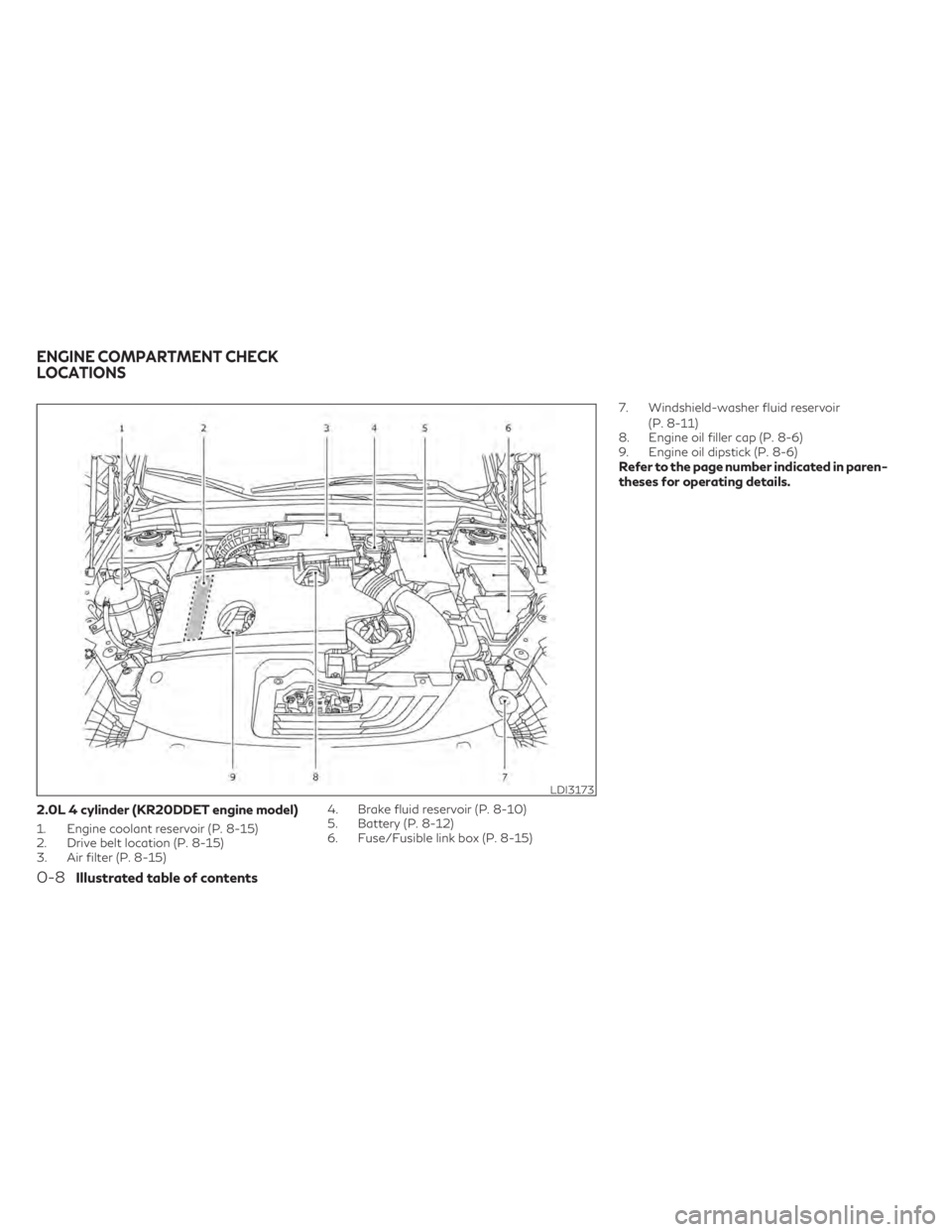
2.0L 4 cylinder (KR20DDET engine model)
1. Engine coolant reservoir (P. 8-15)
2. Drive belt location (P. 8-15)
3. Air filter (P. 8-15)4. Brake fluid reservoir (P. 8-10)
5. Battery (P. 8-12)
6. Fuse/Fusible link box (P. 8-15)7. Windshield-washer fluid reservoir
(P. 8-11)
8. Engine oil filler cap (P. 8-6)
9. Engine oil dipstick (P. 8-6)
Refer to the page number indicated in paren-
theses for operating details.
LDI3173
ENGINE COMPARTMENT CHECK
LOCATIONS
0-8Illustrated table of contents
Page 84 of 542
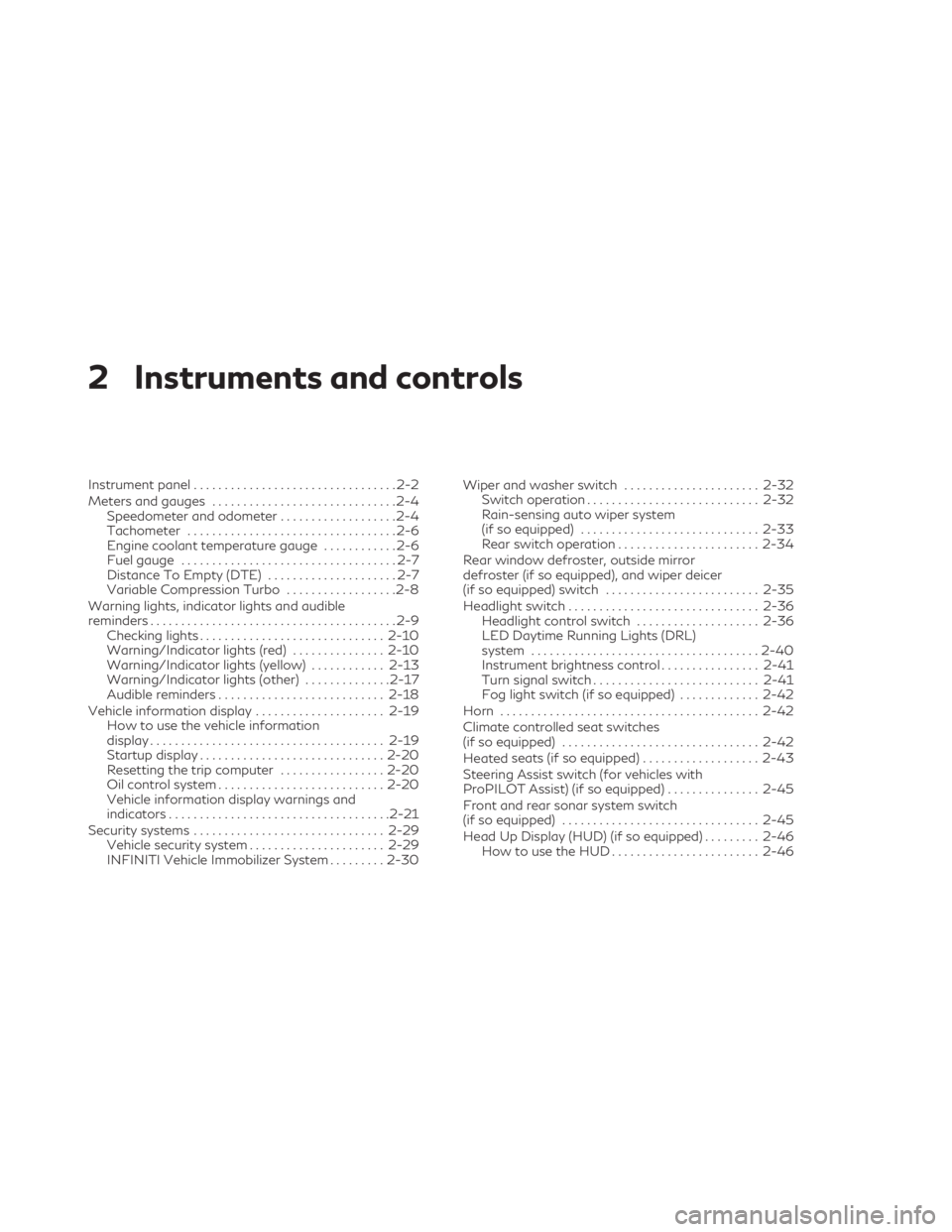
2 Instruments and controls
Instrument panel.................................2-2
Meters and gauges ..............................2-4
Speedometer and odometer ...................2-4
Tachometer ..................................2-6
Engine coolant temperature gauge ............2-6
Fuel gauge ...................................2-7
Distance To Empty (DTE) .....................2-7
Variable Compression Turbo ..................2-8
Warning lights, indicator lights and audible
reminders ........................................2-9
Checking lights .............................. 2-10
Warning/Indicator lights (red) ...............2-10
Warning/Indicator lights (yellow) ............2-13
Warning/Indicator lights (other) ..............2-17
Audible reminders ........................... 2-18
Vehicle information display .....................2-19
How to use the vehicle information
display ...................................... 2-19
Startup display .............................. 2-20
Resetting the trip computer .................2-20
Oil control system ........................... 2-20
Vehicle information display warnings and
indicators .................................... 2-21
Security systems ............................... 2-29
Vehicle security system ......................2-29
INFINITI Vehicle Immobilizer System .........2-30 Wiper and washer switch
......................2-32
Switch operation ............................ 2-32
Rain-sensing auto wiper system
(if so equipped) ............................. 2-33
Rear switch operation ....................... 2-34
Rear window defroster, outside mirror
defroster (if so equipped), and wiper deicer
(if so equipped) switch ......................... 2-35
Headlight switch ............................... 2-36
Headlight control switch ....................2-36
LED Daytime Running Lights (DRL)
system ..................................... 2-40
Instrument brightness control ................2-41
Turn signal switch ........................... 2-41
Fog light switch (if so equipped) .............2-42
Horn .......................................... 2-42
Climate controlled seat switches
(if so equipped) ................................
2-42
Heated
seats (if so equipped) ...................2-43
Steering Assist switch (for vehicles with
ProPILOT Assist) (if so equipped) ...............2-45
Front and rear sonar system switch
(if so equipped) ................................ 2-45
Head Up Display (HUD) (if so equipped) .........2-46
HowtousetheHUD........................ 2-46
Page 88 of 542

1. Tachometer
2. Warning and indicator lights
3. Vehicle information displayOdometer
Twin trip odometer
Transmission position indicator 4. Speedometer
5. Fuel gauge
6. Engine coolant temperature gauge
SPEEDOMETER AND
ODOMETER
This vehicle is equipped with a speedometer
and odometer. The speedometer is located
on the right side of the meter cluster. The
odometer is located within the vehicle infor-
mation display.
LIC4174
METERS AND GAUGES
2-4Instruments and controls
Page 90 of 542

TACHOMETER
The tachometer indicates engine speed in
revolutions per minute (rpm). Do not rev the
engine into the red zone
O1.
CAUTION
When engine speed approaches the red
zone, reduce engine speed. Operating the
engine in the red zone may cause serious
engine damage.
ENGINE COOLANT
TEMPERATURE GAUGE
The gauge indicates the engine coolant tem-
perature. The engine coolant temperature is
within the normal range
O1when the gauge
needle points within the zone shown in the
illustration.
The engine coolant temperature varies with
the outside air temperature and driving
conditions.
CAUTION
If the gauge indicates coolant temperature
near the hot (H) end of the normal range,
reduce vehicle speed to decrease tempera-
ture. If the gauge is over the normal range,
stop the vehicle as soon as safely possible.
If the engine is overheated, continued op-
eration of the vehicle may seriously dam-
age the engine. For additional information,
see “If your vehicle overheats” (P. 6-7) for
immediate action required.
LIC3849LIC3850
2-6Instruments and controls
Page 235 of 542
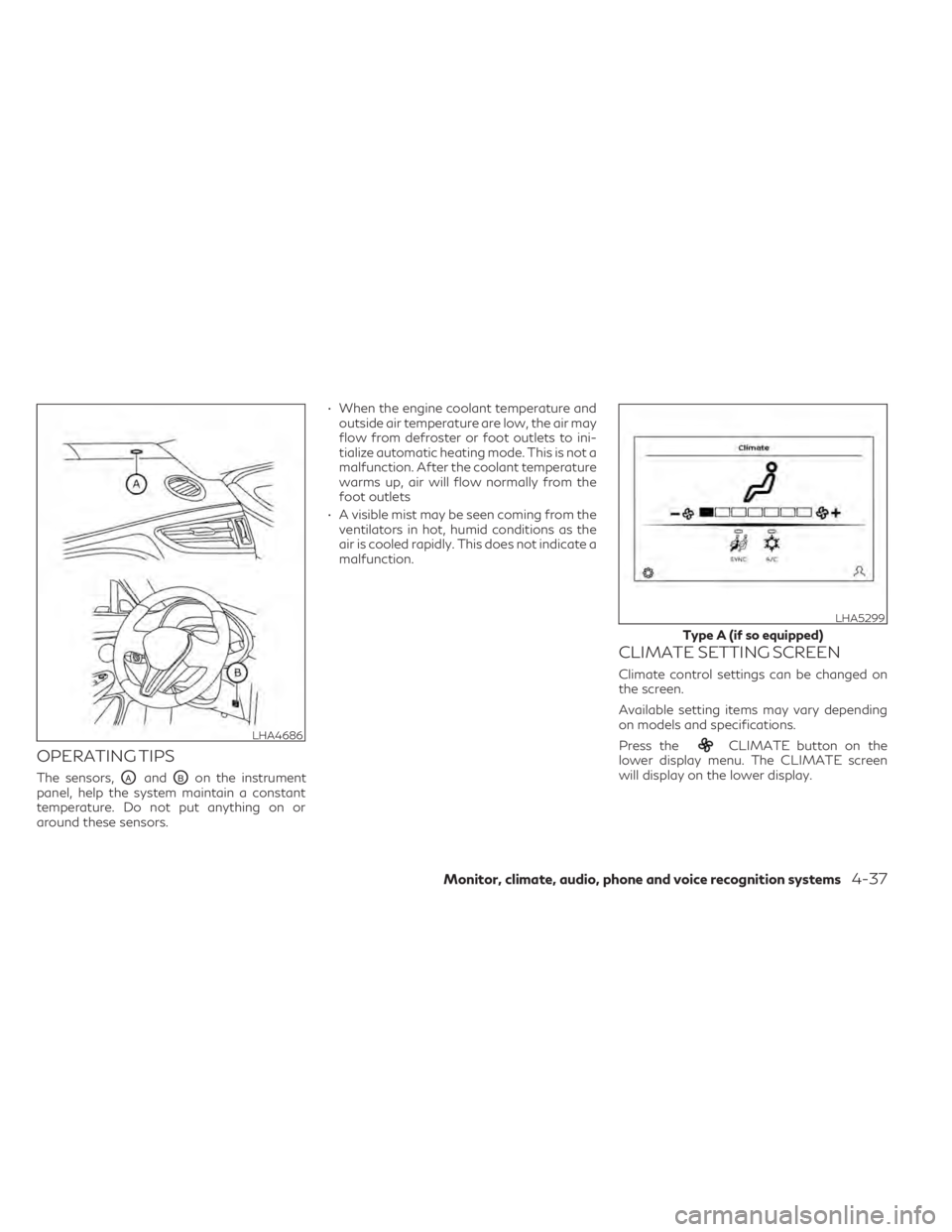
OPERATING TIPS
The sensors,OAandOBon the instrument
panel, help the system maintain a constant
temperature. Do not put anything on or
around these sensors. • When the engine coolant temperature and
outside air temperature are low, the air may
flow from defroster or foot outlets to ini-
tialize automatic heating mode. This is not a
malfunction. After the coolant temperature
warms up, air will flow normally from the
foot outlets
• A visible mist may be seen coming from the ventilators in hot, humid conditions as the
air is cooled rapidly. This does not indicate a
malfunction.
CLIMATE SETTING SCREEN
Climate control settings can be changed on
the screen.
Available setting items may vary depending
on models and specifications.
Press the
CLIMATE button on the
lower display menu. The CLIMATE screen
will display on the lower display.LHA4686
LHA5299
Type A (if so equipped)
Monitor, climate, audio, phone and voice recognition systems4-37
Page 245 of 542

How to enable/disable the sonar system....5-162
Sonar limitations ........................... 5-163
System temporarily unavailable .............5-164
System maintenance ....................... 5-164
Cold weather driving .......................... 5-165
Freeing a frozen door lock ..................5-165
Antifreeze ................................. 5-165
Battery .................................... 5-165
Draining of coolant water ..................5-165Tire equipment
............................. 5-165
Special winter equipment ...................5-166
Driving on snow or ice ...................... 5-166
Engine block heater (if so equipped) .........5-166
Active noise cancellation/Active sound
enhancement ................................. 5-167
Active noise cancellation ...................5-167
Active sound enhancement .................5-168
Page 317 of 542

FCC Warning
Changes or modifications not expressly ap-
proved by the party responsible for compli-
ance could void the user’s authority to oper-
ate the equipment.
For Canada
Applicable law: Canada 310
This device complies with Industry Canada
licence-exempt RSS standard(s).
Operation is subject to the following two
conditions: (1) This device may not cause in-
terference, and (2) this device must accept
any interference, including interference that
may cause undesired operation of the device.
Frequency bands: 24.05–24.25GHz
Output power: less than 20 milliwatts
Radio frequency statement
(Type B) (if so equipped)
For USA
FCC: OAYSRR3B
This device complies with part 15 of the FCC
Rules.
Operation is subject to the following two
conditions: (1) this device may not cause
harmful interference, and (2) this device mustaccept any interference received, including
interference that may cause undesired
operation.
FCC Warning
Changes or modifications not expressly ap-
proved by the party responsible for compli-
ance could void the user’s authority to oper-
ate the equipment.
For Canada
Applicable law: Canada 310
This device contains licence-exempt
transmitter(s)/receiver(s) that comply with
Innovation, Science and Economic Develop-
ment Canada’s licence-exempt RSS(s).
Operation is subject to the following two
conditions: (1) This device may not cause in-
terference, and (2) This device must accept
any interference, including interference that
may cause undesired operation of the device.
Radio frequency radiation exposure informa-
tion: This equipment complies with radiation
exposure limits set forth for an uncontrolled
environment. This equipment should be in-
stalled and operated with minimum distance
of 20 cm between the radiator and your
body.
PRECAUTIONS ON CRUISE
CONTROL
1. RES+ switch
2. SET– switch
3. Cruise control
switch
4. CANCEL switch
• If the cruise control system malfunctions, it will cancel automatically. The
indica-
tor in the vehicle information display will
blink to warn the driver.
• If the engine coolant temperature becomes excessively high, the cruise control system
will be canceled automatically.
LSD2929
CRUISE CONTROL (if so equipped)
Starting and driving5-75
Page 407 of 542
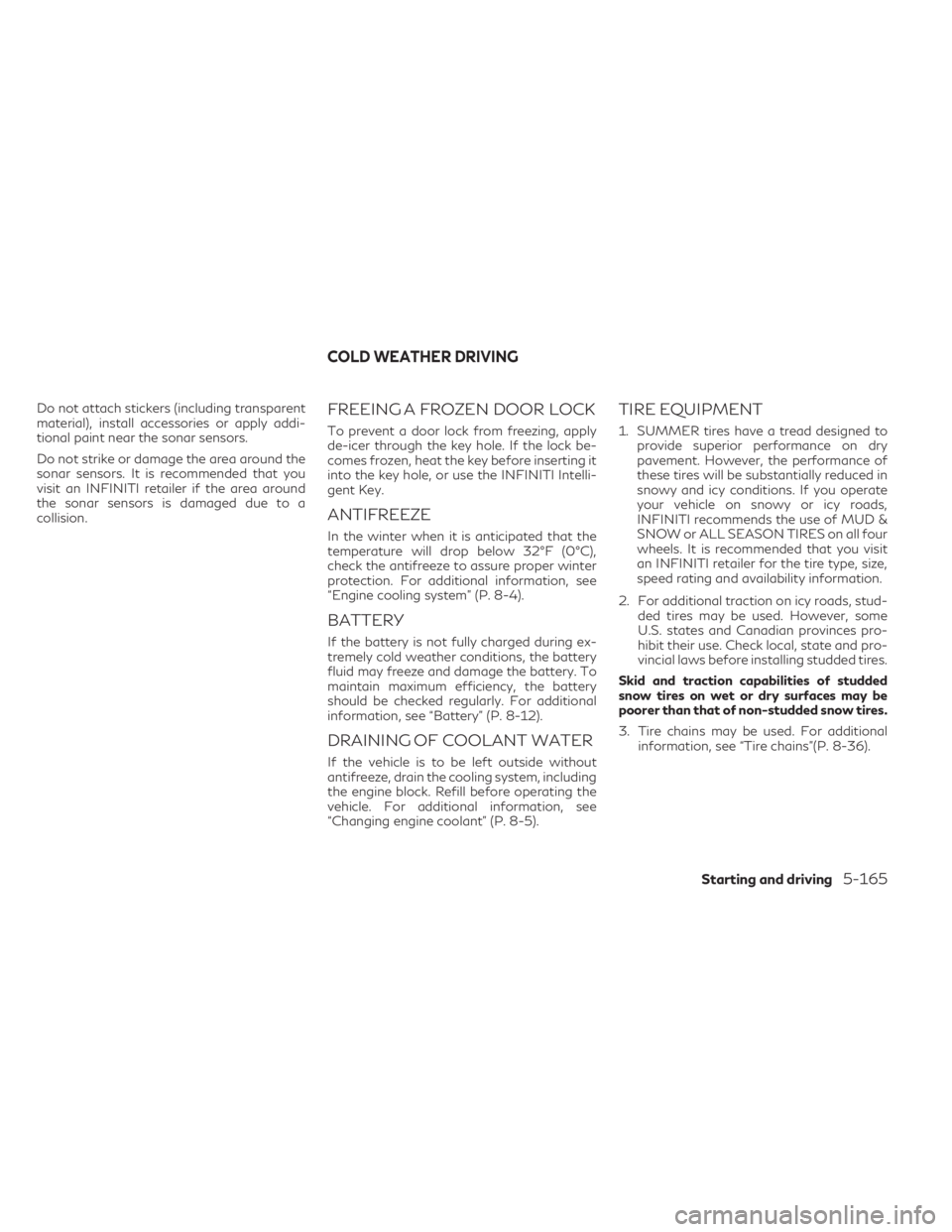
Do not attach stickers (including transparent
material), install accessories or apply addi-
tional paint near the sonar sensors.
Do not strike or damage the area around the
sonar sensors. It is recommended that you
visit an INFINITI retailer if the area around
the sonar sensors is damaged due to a
collision.FREEING A FROZEN DOOR LOCK
To prevent a door lock from freezing, apply
de-icer through the key hole. If the lock be-
comes frozen, heat the key before inserting it
into the key hole, or use the INFINITI Intelli-
gent Key.
ANTIFREEZE
In the winter when it is anticipated that the
temperature will drop below 32°F (0°C),
check the antifreeze to assure proper winter
protection. For additional information, see
“Engine cooling system” (P. 8-4).
BATTERY
If the battery is not fully charged during ex-
tremely cold weather conditions, the battery
fluid may freeze and damage the battery. To
maintain maximum efficiency, the battery
should be checked regularly. For additional
information, see “Battery” (P. 8-12).
DRAINING OF COOLANT WATER
If the vehicle is to be left outside without
antifreeze, drain the cooling system, including
the engine block. Refill before operating the
vehicle. For additional information, see
“Changing engine coolant” (P. 8-5).
TIRE EQUIPMENT
1. SUMMER tires have a tread designed toprovide superior performance on dry
pavement. However, the performance of
these tires will be substantially reduced in
snowy and icy conditions. If you operate
your vehicle on snowy or icy roads,
INFINITI recommends the use of MUD &
SNOW or ALL SEASON TIRES on all four
wheels. It is recommended that you visit
an INFINITI retailer for the tire type, size,
speed rating and availability information.
2. For additional traction on icy roads, stud- ded tires may be used. However, some
U.S. states and Canadian provinces pro-
hibit their use. Check local, state and pro-
vincial laws before installing studded tires.
Skid and traction capabilities of studded
snow tires on wet or dry surfaces may be
poorer than that of non-studded snow tires.
3. Tire chains may be used. For additional information, see “Tire chains”(P. 8-36).
COLD WEATHER DRIVING
Starting and driving5-165
Page 409 of 542

4. Plug the extension cord into a GroundFault Interrupt (GFI) protected, grounded
110-volt AC (VAC) outlet.
5. The engine block heater must be plugged in for at least2-4hours, depending on
outside temperatures, to properly warm
the engine coolant. Use an appropriate
timer to turn the engine block heater on.
6. Before starting the engine, unplug and properly store the cord to keep it away
from moving parts.
ACTIVE NOISE CANCELLATIONThis system uses microphonesO1located
inside the vehicle to detect engine booming
noise. The system then automatically gener-
ates a noise canceling sound through the
speakers and woofer (if so equipped) to re-
duce engine booming noise.
NOTE:
To operate the active noise cancellation
system properly:
• Do not cover the speakers or woofer (if so equipped).
• Do not cover the microphones.
LSD2959
Front Microphone
LSD2960
Rear Microphone
ACTIVE NOISE CANCELLATION/
ACTIVE SOUND ENHANCEMENT
Starting and driving5-167